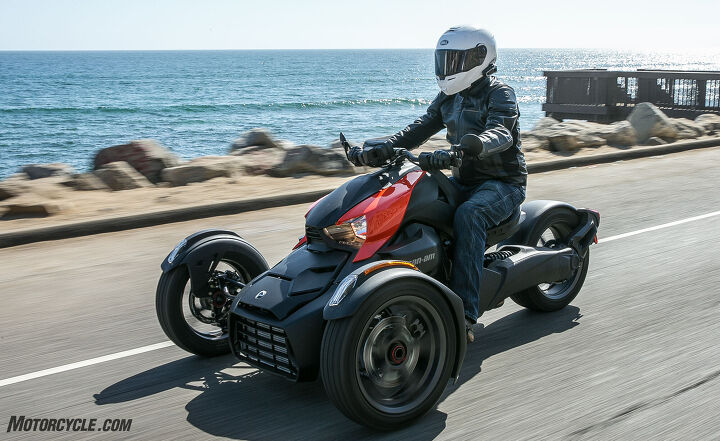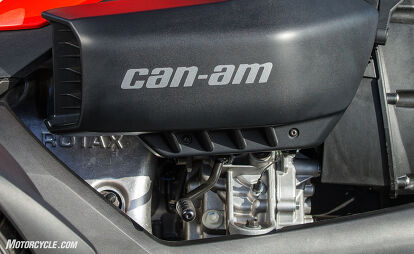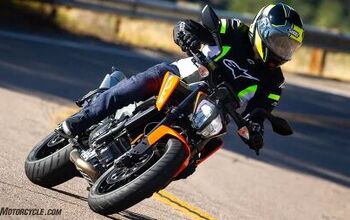2019 Can-Am Ryker Review - First Ride

Easy-to-ride now becomes easier-to-own while retaining the fun
Can-Am’s Spyder line of three-wheeled vehicles has always been about easy entry into the power sports market. Spyders are undeniably easier for beginners to ride than motorcycles. First, 3-wheelers support themselves at a stop. Second, operating them is initially more intuitive than a motorcycle. Also, in some states, California being a prime example, no special license is required to operate them on a public roadway. However, there was one area that put a major barrier to entry – price. For 2019, starting prices for Spyders range from $15,999 to $24,599 – not an amount to be sneezed at, though lower than in 2018. To appeal to a wider group of prospective riders, Can-Am needed a way to ease the entry into the market. That’s where the Can-Am Ryker, with its base price starting at $8,499, comes into play.
2019 Can-Am Ryker
| Engine | 16.0/20 |
| Suspension/Handling | 12.0/15 |
| Transmission/Clutch | 9.0/10 |
| Brakes | 8.5/10 |
| Instruments/Controls | 3.5/5 |
| Ergonomics/Comfort | 8.75/10 |
| Appearance/Quality | 8.5/10 |
| Desirability | 8.0/10 |
| Value | 9.0/10 |
| Overall Score | 83.25/100 |
To introduce the Ryker to the world, Can-Am gathered the international moto-press in Los Angeles for a day of riding in the Santa Monica Mountains to let us get a feel for what this new machine has to offer, and I’ll give you my first impression right away: It’s pretty dang fun.
Can-Am created three versions of the Ryker. Two are based on a Rotax 600cc Twin ($8,499) and a Rotax 600cc Triple ($9,999). The third variation is the Ryker Rally Edition ($10,999), which has a 900cc Rotax Triple, longer travel suspension, gravel-oriented tires, and underbody protection. Since Can-Am only brought the 900cc Rykers to the intro, my review will focus on it.
Can-Am claims the 900 cranks out 77 hp. To make the Ryker easier to ride – even easier than the 6-speed semi-automatic fit to the Spyder line – a CVT handles getting the power from the engine to the rear wheel. While many motorcyclists think of a CVT as a scooter transmission, Can-Am knows better. It’s parent company BRP has a ton of experience with CVTs in performance vehicles – just look at their snowmobile and ATV offerings.
With a claimed 77-hp output from the Rotax 900 ACE Triple and a claimed dry weight of 616 lb., Can-Am says that the Ryker has a similar power-to-weight ratio to the Spyder F3, which has a bigger engine but carries approximately 300 lb. more heft. This translates into the entry-level 900cc 3-wheeler having similar scoot to the sporty Spyder for around $6,000 less.
To riders accustomed to manual transmissions and separate front and rear brakes, the first look at the Ryker’s handlebar will seem odd. There’s nothing but grips and switch gear. The ride-by-wire throttle still twists, but the CVT has taken care of the clutch lever. Like its Spyder brethren, the Ryker’s braking is handled by a pedal on the right peg. On the left side of the engine, well above the peg, a lever for switching between forward and reverse is easy to operate, once you get the knack for its awkward position and arc of adjustment. The parking brake is tucked away by the rider’s left knee for easy access.
Can-Am has further refined its Ufit system, making the fine-tuning of the rider’s position super easy. The handlebar adjusts simply by lifting the lever and sliding the bar forward or aft over its approximately 2-inch range, then lowering the lever back down to its locked position. This process is so easy that a rider could have two preferred bar positions, one for the city and another for extended highway stints. The pegs can be adjusted over roughly 12 inches of range in a similarly easy method. Just lift the peg, slide the mount to the desired location, and lower the peg back down into its locked position. Because peg location also affects the angle that the rider’s foot hits the brake pedal, it, too, can be easily adjusted without tools when the peg is in its unlocked position. Very clever and convenient.
If the CVT is the biggest functional break between the Ryker and the Spyder, the single-sided swingarm with its internal shaft drive is the biggest visual change. How Can-Am was able to fit a seemingly pricy feature in such a price-point directed vehicle is beyond me, but it radically changes the look of the back end of the Ryker. Similarly, the use of a single nut to retain each of the three wheels gives a premium feel.
The riding experience of the Ryker, with the exception of the CVT, is all Spyder – and that’s a good thing. To get the Ryker under way, the rider merely twists the throttle. The CVT takes care of the rest. While the initial application of the throttle sometimes delivers an audible thunk if the throttle was rolled on too abruptly, the rest of the CVT’s operation is remarkably smooth. Around town, the engine is kept in its optimal rpm range for quick response. The same is true when the road gets twisty. The CVT always felt like it was in the appropriate ratio for the speed the Ryker was going.
The Ryker, with its low center of gravity, in part due to how the rider sits in it rather than up on top of it, helps it to deliver sporty cornering. Yes, if you push it too hard, the Vehicle Stability System will intercede, but overall, the VSS feels less intrusive than with the Spyder models. Still, if you enter a corner too hot, the VSS will apply the brake on the outside front wheel. If you continue to push it, the engine’s power will be reduced. Push even harder, and the Ryker will understeer and run wide.
When it comes time to be a hooligan, the Ryker delivers. Selecting Sport Mode allows the rear wheel to spin up much more than any of the Spyders I’ve previously ridden. If the rider applies the brake while spinning the rear wheel, the Ryker is capable of performing smoky, block-long burn outs to your heart’s content. And I did on the day’s ride.
Another key feature of the Ryker is its ease of customization. When you purchase a Ryker you have a choice of three color options (Intense Black, Adrenaline Red, or Yellow Shock) for the side panels included with the price. The Epic Series of colors includes three more colors for an additional fee: Carbon Black, Immortal White, and Liquid Steel. Finally, for a little bit more, the Exclusive series features six additional colors that will be offered in limited numbers. This selection will also change every six months, making it highly unlikely that the same color will be encountered out on the road. This is a really clever idea.
In my short time on the Ryker, I found that, despite its dramatically reduced price, it features the same build quality as the more expensive Spyders. The styling is sporty, and the single-sided swingarm gives the Ryker a sporty look that is quite different from the Spyder line. The engine’s power is decent, and the CVT is well executed. Will it attract the younger demographic that it is aimed at? We’ll be watching closely. The Ryker will be available to the public in the first quarter of 2019.
2019 Can-Am Ryker
+ Highs
- Significantly reduced price
- Ufit system quickly tunes riding position
- Easy customization
– Sighs
- Must manually select Sport Mode each time you start the engine
- Small storage compartment
- Awkwardly located reverse lever
In Gear

Helmet: Bell SRT-M $349
- Jacket: Reax Jackson $429
- Pants: Reax 215 Denim Riding Jeans $119
- Boots: Rev’It Regent H2O Boots $350
Gloves: Reax Castor Sport Leather Gloves $89
2019 Can-Am Ryker Specifications | |
|---|---|
| MSRP | $10,999 |
| Engine Type | Rotax 900 ACE in-line Triple, liquid- cooled |
| Bore and Stroke | 74 mm x 69.7 mm |
| Compression Ratio | NA |
| Rear Wheel Horsepower (Claimed) | 77 hp @ 7100 RPM |
| Torque (Claimed) | 56 lb-ft @ 6300 RPM |
| Transmission | CVT |
| Final Drive | Shaft |
| Front Suspension | Double wishbone, SACHS Twin-tube coil-over shocks, 5.39 in. travel |
| Rear Suspension | Multi-link – single-sided swingarm, SACHS Twin-tube coil-over shocks with preload adjustment, 5.91 in. travel |
| Front Brakes | 270 mm discs with Nissin 2-piston floating calipers |
| Rear Brake | 220 mm disc, 1-piston floating caliper |
| Front Tires | MC 145/60R16 66T |
| Rear Tire | MC 205/45R16 77T |
| Wheelbase | 67.3 in. |
| Seat Height | 23.5 in. |
| Curb Weight (Claimed) | 616 lbs. (Dry) |
| Fuel Capacity | 5.28 gal. |
| Colors | Black, Red, Yellow |
| Warranty | 1-year BRP Limited Warranty with 1-year roadside assistance |

Like most of the best happenings in his life, Evans stumbled into his motojournalism career. While on his way to a planned life in academia, he applied for a job at a motorcycle magazine, thinking he’d get the opportunity to write some freelance articles. Instead, he was offered a full-time job in which he discovered he could actually get paid to ride other people’s motorcycles – and he’s never looked back. Over the 25 years he’s been in the motorcycle industry, Evans has written two books, 101 Sportbike Performance Projects and How to Modify Your Metric Cruiser, and has ridden just about every production motorcycle manufactured. Evans has a deep love of motorcycles and believes they are a force for good in the world.
More by Evans Brasfield
























































Comments
Join the conversation
It's possible that with this new, lower-cost model, more of these trikes will be noticed on the road by people who wouldn't even consider riding a motorcycle (or have been discouraged by the price of Spyder models) and suddenly be interested in a relatively safe 3-wheeler experience themselves.
If the logo https://motorcycle-logos.co... is not visible, many will recognize this brand anyway. Or they can guess with a high probability. At least Ryker is superficially hard to miss.